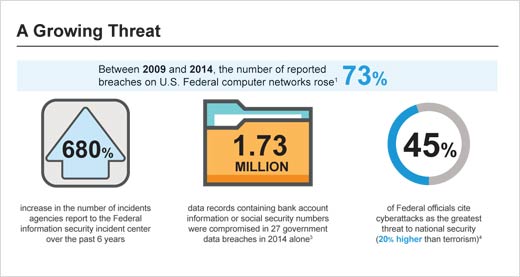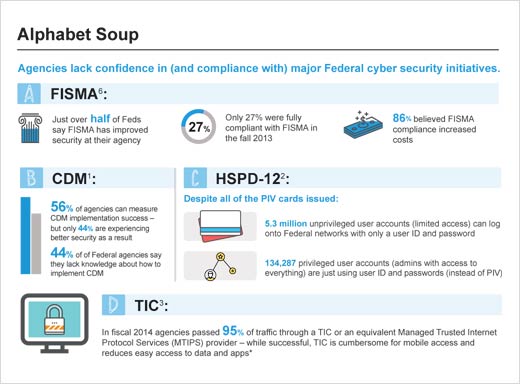Cybersecurity threats are growing. To defend against increasing threats, agencies must comply with various cybersecurity mandates that often fail to take the user experience into account. According to a new MeriTalk report, “Federal Cyber Uncertainty – KVM XYZ,” keyboard-video-mouse (KVM) switching devices may be the solution agencies need when looking for ways to enable productivity while ensuring air-tight seals between networks, protecting from both internal and external threats.
According to the MeriTalk report, delivered as an infographic and sponsored by Belkin Government, Federal managers still lack confidence in their ability to protect sensitive data and experience challenges when it comes to compliance with Federal mandates designed to improve cybersecurity.
Federal Cyber Uncertainty
Click through for findings from a report on Federal cybersecurity, provided by MeriTalk and sponsored by Belkin Government.
A Growing Threat
Between 2009 and 2014, the number of reported breaches on U.S. Federal computer networks rose 73 percent. There was a 680 percent increase in the number of incidents agencies reported to the Federal information security incident center over the past six years, and 1.73 million data records were compromised in 27 government data breaches in 2014 alone. Additionally, 45 percent of Federal officials cite cyberattacks as the greatest threat to national security (20 percent higher than terrorism).
Internal Vulnerabilities
In “Heart of the Network: Data Center Defense,” MeriTalk and Palo Alto Networks surveyed 300 Federal IT decision makers to examine the steps agencies take to keep data secure at each phase of the data center modernization journey – consolidation, virtualization, and cloud migration. The report found the most significant vulnerabilities included denial of service attacks (48 percent), non-public information (45 percent), agency network (44 percent), classified or protection information (39 percent) and system admin accounts (37 percent).
Alphabet Soup
Agencies lack confidence in (and compliance with) major Federal cybersecurity initiatives.
- FISMA: Just over half of Feds say FISMA has improved security at their agency and only 27 percent were perfectly compliant with FISMA in fall 2013. Eighty-six percent believed FISMA compliance increased costs.
- CDM: Fifty-six percent of Federal agencies are able to measure success in their CDM implementation, but only 44 percent are experiencing better security as a result of the CDM controls.
- HSPD-12: Despite all of the PIV cards issued, 5.3 million unprivileged user accounts with limited access can log onto Federal networks with only a user ID and password and 134,287 privileged user accounts – system admins with access to everything – are just using user ID and passwords (instead of PIV).
- TIC: In fiscal 2014, agencies passed 95 percent of traffic through a TIC or an equivalent Managed Trusted Internet Protocol Services (MTIPS) provider – while successful, TIC is cumbersome for mobile access and reduces easy access to data and apps.
The Need for KVM Security
A significant amount of government data resides on endpoints – but 66 percent of Feds say they are missing measures for endpoint security management. Additionally, nearly half of IT and IT security decision makers said government data is most at risk of breach from employees’ or contractors’ desktops or laptops.
Passing the KVM Spelling Test
With KVM, secure switching devices can enable productivity for Feds while ensuring air-tight seals between networks, protecting from both inside and outside threats.








